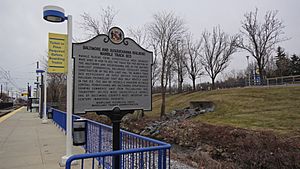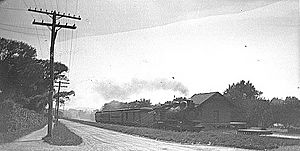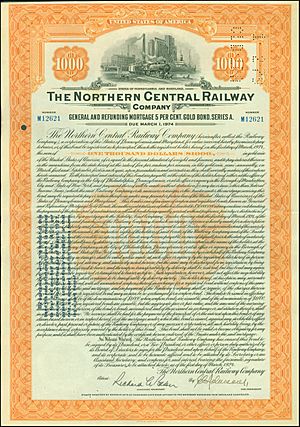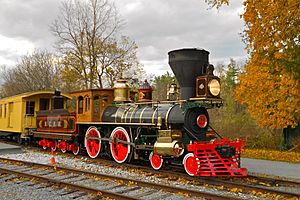Northern Central Railway facts for kids
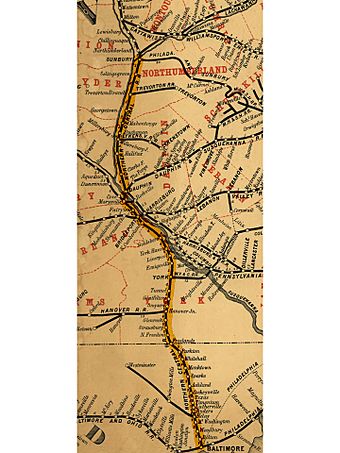
1863 map showing crossing of the Susquehanna River on the Marysville Bridge. Traffic was later routed over the Rockville Bridge.
|
|
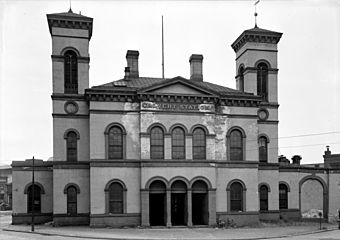
Calvert Street Station at North Calvert and Bath/East Franklin Streets, in downtown Baltimore, built 1849-1850, razed 1949; designed by James Crawford Neilson
|
|
| Overview | |
|---|---|
| Headquarters | Baltimore |
| Reporting mark | NCRY |
| Locale | Pennsylvania and Maryland |
| Dates of operation | 1858–1976 |
| Predecessor | Baltimore and Susquehanna Railroad, York and Maryland Line Rail Road, Susquehanna Railroad |
| Successor | Conrail |
| Technical | |
| Track gauge | 4 ft 8 1⁄2 in (1,435 mm) standard gauge |
| Length | 380 miles (610 km) (including leased lines) |
The Northern Central Railway (NCRY) was a major railroad that connected Baltimore, Maryland, with Sunbury, Pennsylvania. It ran along the Susquehanna River. The railway was finished in 1858.
In 1861, the Pennsylvania Railroad (PRR) took control of the Northern Central. They bought most of its shares to compete with the Baltimore and Ohio Railroad (B&O). For over 100 years, the Northern Central operated as a part of the PRR.
However, in 1972, Hurricane Agnes caused severe damage to its tracks in Maryland. Most of its operations stopped because the Penn Central (a new company formed by PRR and New York Central Railroad) decided not to fix the damaged parts.
Today, the Northern Central Railway no longer exists as a company. Parts of its old tracks in Pennsylvania are now the York County Heritage Rail Trail. This trail connects to a similar walking and biking path in Maryland, called the Torrey C. Brown Rail Trail. Only the tracks around Baltimore are still used for train service.
Contents
Building the Northern Central Railway
Early Railroad Plans in Maryland
The Baltimore and Susquehanna Railroad Company was created on February 13, 1828. It was the second railroad planned in Maryland. Its goal was to build a railway from Baltimore northeast to the Susquehanna River.
To reach a useful point on the Susquehanna, the new line needed to cross into York County, Pennsylvania. However, Pennsylvania's government didn't want its southern counties' trade to go to Baltimore. They preferred it to benefit their own city, Philadelphia. Even though Pennsylvania would gain access to the Chesapeake Bay, its lawmakers didn't want to approve a connecting railroad.
Starting Construction and Facing Challenges
Construction of the Baltimore & Susquehanna Railroad began in 1829. By 1831, it reached Cockeysville, Maryland, north of Baltimore. The railroad then got permission to build northwest towards Westminster, Maryland, and even Gettysburg, Pennsylvania.
Despite strong opposition from Philadelphia, Pennsylvania finally allowed the York and Maryland Line Rail Road to be built on March 14, 1832. This railroad would connect the Baltimore & Susquehanna at the Mason–Dixon line (the state border) with York, Pennsylvania.
Connecting Baltimore to York
The Baltimore & Susquehanna and the York & Maryland Line eventually completed the line from Baltimore to York by 1838. This route included the Howard Tunnel, which is 275 feet long. Built between 1836 and 1837, it opened in 1838. It is the earliest railroad tunnel in the U.S. still used today.
In 1832, the railroad bought its first steam locomotive, named Herald. It was built in England and shipped to America. An engineer came with it to teach Americans how to operate it.
The railway also built Bolton Station in 1832. It was the first train station in Baltimore. It had a roundhouse and shops nearby.
Expanding North and New Stations
By April 1840, the Wrightsville, York & Gettysburg R.R. was finished between York and Wrightsville, Pennsylvania. There, it connected to the Columbia-Wrightsville Bridge. This allowed trains to cross the Susquehanna River and reach other railroads. This new route offered another way to ship goods from central Pennsylvania to Maryland's seaports.
In 1850, the Baltimore & Susquehanna system opened Calvert Street Station in downtown Baltimore. This station was designed by a famous architect, James Crawford Neilson.
On April 14, 1851, the Susquehanna Railroad was created. Its goal was to build north from York & Cumberland up the Susquehanna River to Sunbury, Pennsylvania. This was a big project that needed a lot of money.
Forming the Northern Central Railway
A financial crisis in 1853 caused problems for the Baltimore & Susquehanna and its related railroads. To solve this, the Maryland and Pennsylvania governments allowed the Baltimore & Susquehanna, York & Maryland Line, York & Cumberland, and Susquehanna Railroads to merge.
On December 16, 1854, these companies officially combined to form the Northern Central Railway Company.
Construction on the northern extension resumed in 1855. By 1856, the line had bridged the Susquehanna at Dauphin, Pennsylvania, and reached Millersburg, Pennsylvania. This connected to other lines that brought coal from mines. In 1858, the line finally opened all the way to Sunbury.
In 1861, the Pennsylvania Railroad (PRR) gained control of the Northern Central's shares. From then on, the Northern Central operated as a part of the PRR.
On February 23, 1861, President-elect Abraham Lincoln was supposed to arrive at Calvert Station. However, due to a plot to assassinate him in Baltimore, Lincoln changed his plans. He arrived earlier at President Street Station, avoiding the danger.
The Civil War and Beyond
Northern Central's Role in the Civil War
During the American Civil War, the Northern Central Railway was very important. It transported supplies, food, clothing, and military equipment. It also moved troops heading south from places like Camp Curtin.
In 1863, during the Gettysburg Campaign, Confederate General Jubal Early raided the NCRY. His troops burned some trains and workshops in York. They also destroyed many bridges in York County to stop traffic between Baltimore and Harrisburg. However, these bridges were quickly rebuilt by the U.S. Military Railroad and the NCRY.
Traffic soon restarted. Thousands of wounded soldiers from the Battle of Gettysburg were taken by the Northern Central to hospitals in Harrisburg, Baltimore, and York.
The Northern Central was attacked again on July 10, 1864. A group of Confederate cavalry cut telegraph wires near Cockeysville.
Lincoln's Journeys on the NCRY
Abraham Lincoln traveled on the Northern Central in November 1863 to deliver the Gettysburg Address. He changed trains at Hanover Junction, Pennsylvania.
After Lincoln's assassination in 1865, his body was carried on the same rails. His funeral train left Washington, D.C., on April 21, 1865. It arrived at Baltimore's Camden Station. After people viewed the President's body, the train left Baltimore on the Northern Central. It arrived in Harrisburg with a brief stop in York.
Connecting Cities and Expanding Services
In 1873, the NCRY opened its Charles Street Station. The Union Railroad of Baltimore also opened a new line that connected to this station. This new line gave the NCRY access to the Canton area in Baltimore. There, it built a shipping terminal on the Inner Harbor. This link also connected the NCRY with other major railroads in central Baltimore.
In February 1882, the Northern Central bought the Union Railroad. This allowed the PRR to run trains directly between Philadelphia, Baltimore, and Washington, D.C. This route created strong competition for the B&O. Today, this PRR system is part of the Northeast Corridor.
In 1898, the NCRY built the Millersburg Passenger Rail Station.
The Twentieth Century and End of Operations
By World War I, the Pennsylvania Railroad's Northern Central line had two tracks and block signals between Baltimore and Harrisburg. The line carried a lot of passenger and freight traffic until the 1950s.
Trains carried goods like flour, paper, milk, farm products, and coal. Local commuter service ran between Baltimore and Parkton, Maryland. Long-distance passenger trains, with sleeping cars and dining cars, also ran from Baltimore to cities like Buffalo, Toronto, Chicago, and St. Louis.
In the 1950s, fewer people and goods were traveling by train. The Baltimore-Harrisburg Expressway (I-83) was built, which also reduced rail traffic. The local commuter trains stopped in 1959. The line was changed from two tracks to one. Some long-distance trains continued until the late 1960s.
In 1972, Hurricane Agnes caused major damage to bridges and tracks along the line. Because of this, the Northern Central Railway stopped operating completely. It had been running for 134 years.
Penn Central and What Happened Next
In 1968, the PRR merged with the New York Central Railroad to form the Penn Central (PC).
After Hurricane Agnes damaged the main line, the Penn Central asked for permission to abandon the railroad south of York. The section of the line between York and New Freedom was bought by the Pennsylvania Department of Transportation in June 1973.
The Penn Central faced many problems, including old government rules, rising prices, strict union rules, and bad management. It also had very bad weather. In 1970, the Penn Central had to file for bankruptcy. It operated under court supervision until 1976. Then, its lines were transferred to Conrail, a new company.
Northern Central's Legacy Today
A 13-mile part of the old Northern Central, between Baltimore and Cockeysville, was used by Norfolk Southern Railway (NS) until 2005. This section was rebuilt and electrified in the late 1980s for the Baltimore Light Rail system. NS freight trains were allowed to use the Light Rail line late at night when no passenger trains were running. NS stopped its freight service on this line in 2005.
Rail Trails for Fun
The Maryland Department of Natural Resources turned the old railroad corridor north of Cockeysville into a trail. It opened to the public in 1984. It is officially called the Torrey C. Brown Rail Trail, but many people still call it the Northern Central Railroad (NCR) Trail. This trail continues into Pennsylvania, where it becomes the York County Heritage Rail Trail.
In York County, several old bridges and the New Freedom Railroad Station are listed on the National Register of Historic Places.
A Heritage Railway Experience
A heritage railroad operated on the NCRY line as a dinner train from the mid-1990s to the early 2000s.
In 2013, a group called Steam into History began operating trains between New Freedom and Hanover Junction. They use a replica of a Civil War-era steam locomotive.
Images for kids


